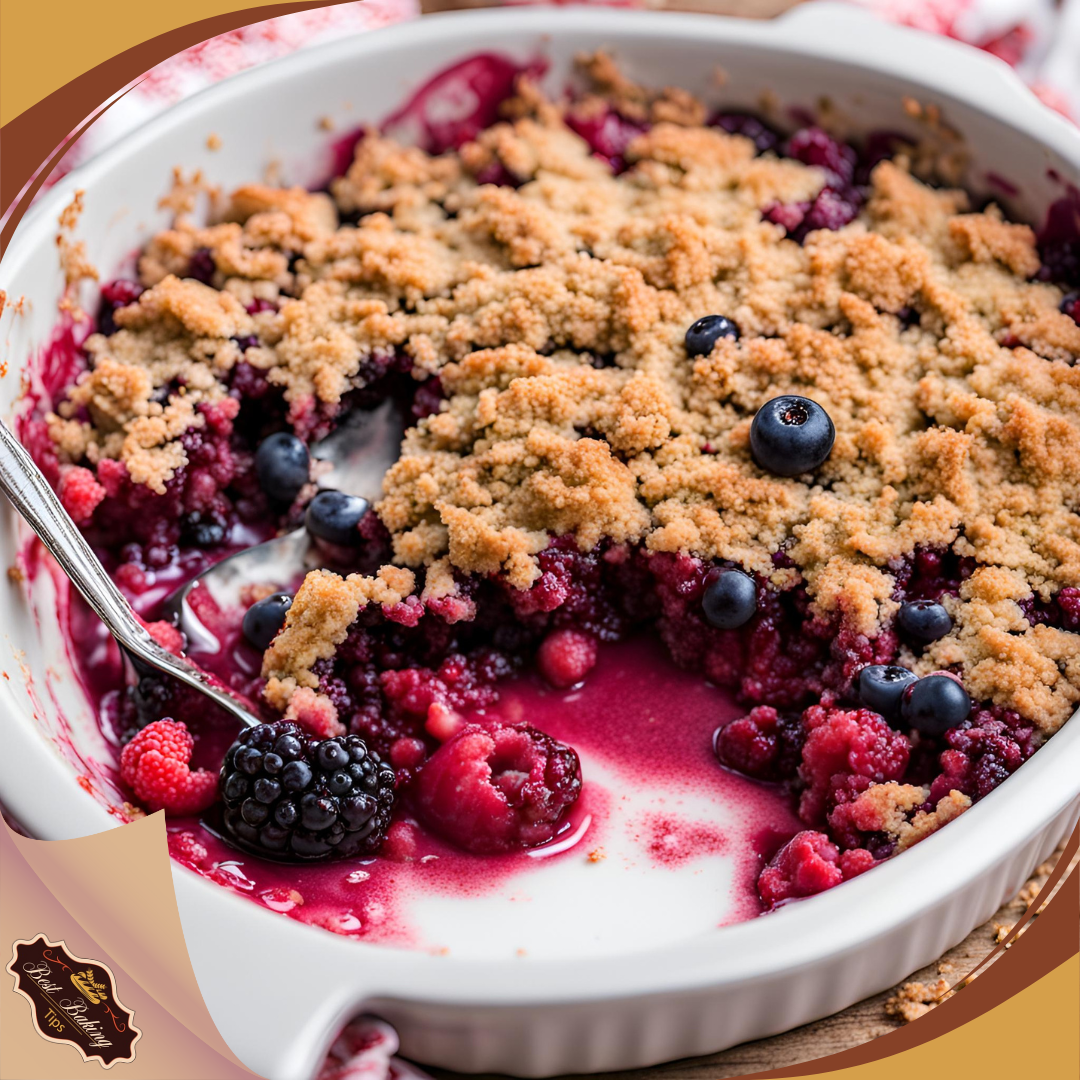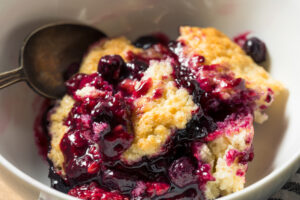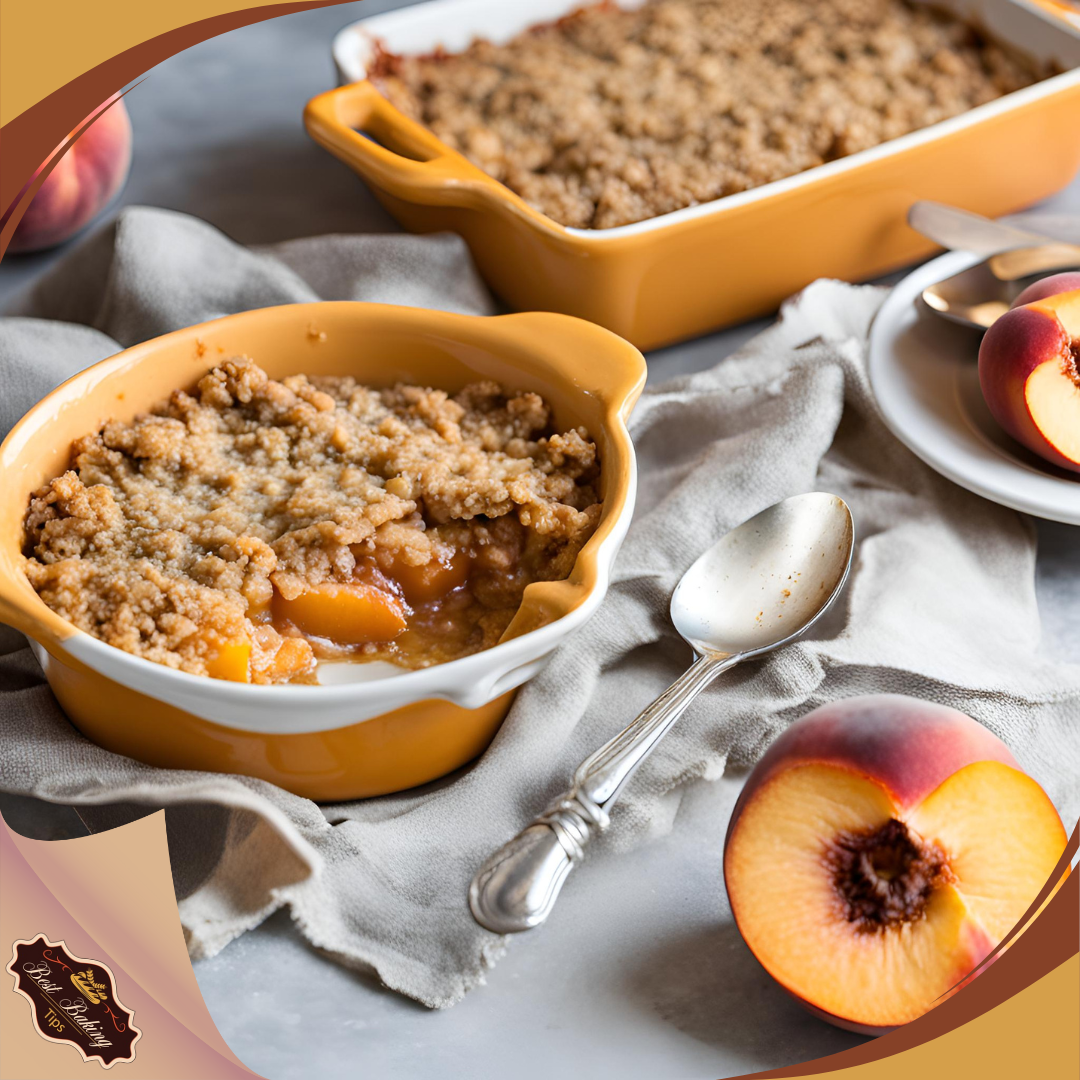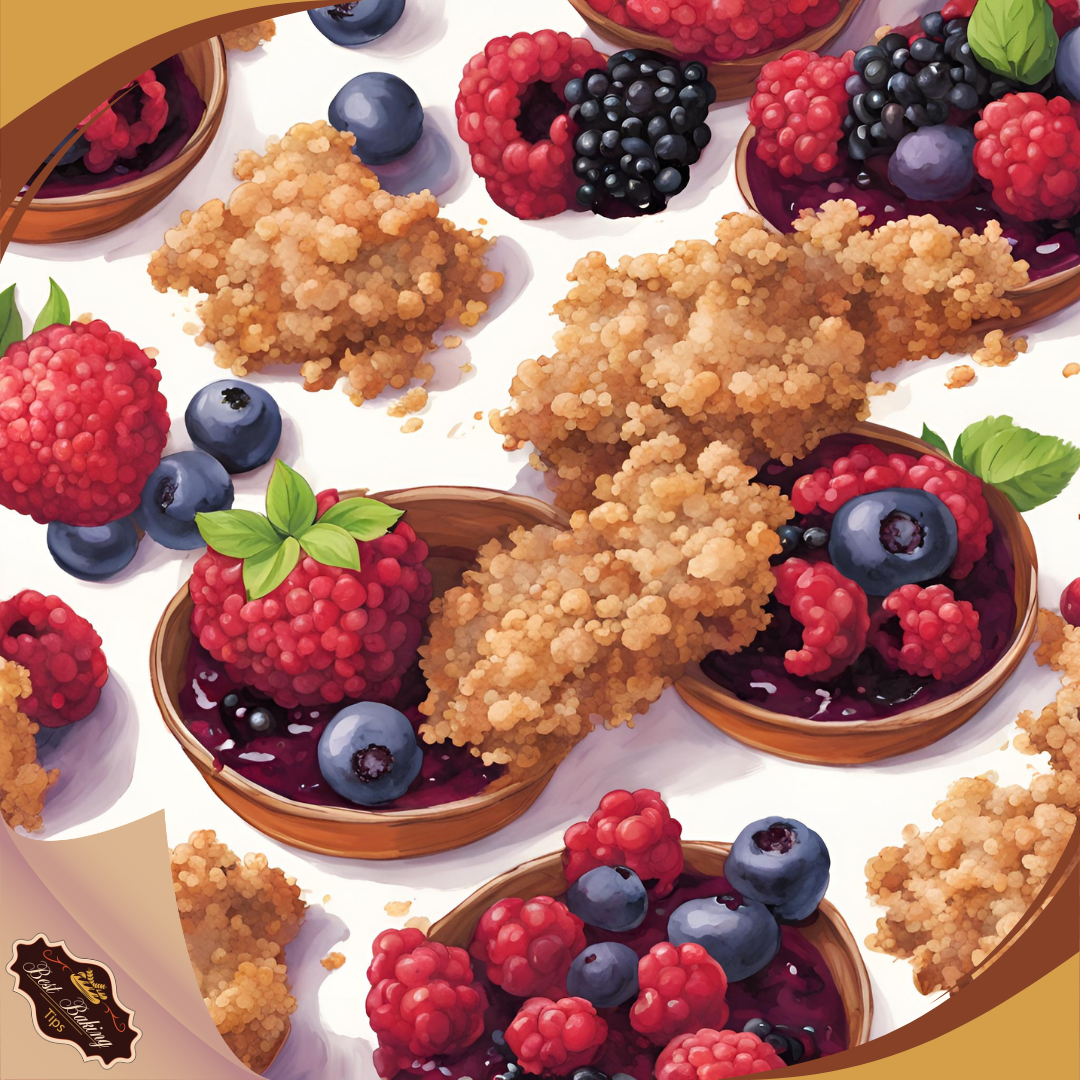==================
Affiliate Statement
Best Baking Tips is supported by our audience. When you purchase through one of our links, we may earn a small affiliate commission. As an Amazon Associate I earn from qualifying purchases. Your cost is not affected.
==================
Cobbler, crisp, and crumble: three tantalizing options, but which will win your heart?
Delicious, comforting, and oh-so-satisfying—cobblers, crisps, and crumbles have long tantalized our taste buds with their fruity goodness and delectable toppings. But amidst the array of options, one question lingers: which reigns supreme?
Accompany us as we unravel the nuances of these beloved desserts, exploring their origins, textures, and cultural significance. Prepare to embark on a culinary journey where every bite sparks a delicious debate.
Cobbler, Crisp, and Crumble: Deciphering the Delights of Fruit Desserts
When it comes to classic fruit-based desserts, the terms cobbler, crisp, and crumble often come up. While these dishes share similarities, such as a fruit filling, they differ distinctly in their toppings and origins.
A cobbler is typically made with a biscuit-style dough dropped in dollops over the fruit, creating a cobblestone effect when baked.

Conversely, a crisp includes a topping that often has a combination of oats and nuts, giving it a crunchy texture after baking.
A crumble, on the other hand, has a topping that is more like a streusel, made from butter, flour, and sugar, and lacks the oats found in a crisp, although it can sometimes contain nuts.
These differences not only affect the texture but also the taste and presentation of each dessert.
With their straightforward preparation techniques and versatility, all three desserts have become staples in home cooking and have various adaptations around the world, showing their cultural significance and adaptability.
Understanding the nuances of each can enhance the way they are served and enjoyed, making them a delightful addition to any meal.

Key Takeaways
- Each dessert—cobbler, crisp, and crumble—has a unique topping and texture.
- The preparation methods and ingredients used distinguish these classic desserts.
- They have evolved with cultural significance and a variety of adaptations.
Exploring The Basics
When preparing dessert, the distinction between a cobbler, crisp, and crumble is often found in their toppings and texture. Understanding their differences ensures that every spoonful meets your baking expectations.

Berry Cobbler
Warm Comfort Cobbler
A cobbler is characterized by a fruit filling, typically made with peaches, berries, or apples, which is then covered with a batter or biscuit-like topping before baking.
When cooked, the topping is thick and cakey on the inside, with a golden-brown surface. This type of dessert gets its name because the lumps of cooked dough resemble cobblestones.

Peach Crisp
Fruitful Crisp
In the realm of fruit desserts, a crisp takes fresh fruit and tops it with a mixture that gets delightfully crunchy as it bakes.
The crumbly topping is generally composed of oats, butter, flour, and sugar, giving a crisp its signature textured bite that contrasts with the soft fruit beneath.

Berry Crumble
Craving Crumble?
On the other hand, a crumble is akin to a crisp, sans the oats, granting it a softer, more streusel-like quality.
It combines butter, sugar, and flour to create a sweet, crumbly topping that complements the fruit filling without the additional crunch.
A crumble is a favorite for those who prefer a dessert that focuses more on the tender fruit center and a melt-in-your-mouth topping.
Historical Background
In exploring the layered history of desserts like cobblers, crisps, and crumbles, we uncover a culinary tale steeped in cultural tradition and innovative adaptation.

Origins of Cobbler
I understand cobbler to be a fruit dessert, originating in the American colonies during the 19th century. Settlers struggled to make traditional English puddings due to lack of suitable ingredients and equipment.
Thus, they improvised by covering stewed fruit with a rough assembly of biscuit or dumpling dough, giving rise to the rustic dish known as cobbler.
Evolution of Crisp
The term “crisp” surfaced in a 1916 recipe according to Bon Appétit, referring to a dessert with a topping that became notably crunchy upon baking.
This dessert variant evolved with the incorporation of oats, which contributed to the crisp texture of the topping, distinguishing it from its cousin, the crumble.
Development of Crumble
My research indicates that the crumble also had its early beginnings in wartime Britain.
During World War II, when rationing made pie crusts a luxury, the crumble gained popularity as an economical alternative.
A simple mixture of butter, flour, and sugar was used to create a lumpy, streusel-like topping over fruit, as described by Allrecipes.
Key Ingredients
When I make cobbler, crisp, or crumble, I focus on the distinctive combination of ingredients that sets each dessert apart.

Cobbler Ingredients
For a cobbler, I use fruit as the base, typically berries, peaches, or apples.
The topping is biscuit-like and consists of flour, sugar, butter, milk, and a leavening agent like baking soda or baking powder to give it a puffed appearance when baked.
Crisp Ingredients
Making a crisp, I include oats in the streusel topping, mixed with butter, sugar, and flour. This gives the crisp its characteristic crunchy texture once it is baked.
I often toss in nuts for added crunch.
Crumble Ingredients
In contrast, a crumble doesn’t use oats in the topping.
Instead, I focus on a blend of sugar, butter, and flour, creating a softer and more clumpy appearance. Nuts can be added but are not mandatory.

Preparation Techniques
I will unravel the distinct baking methods for cobblers, crisps, and crumbles, focusing on how each one’s preparation technique contributes to its unique texture and taste.

Baking Cobbler
When I bake a cobbler, my goal is to achieve a fluffy, biscuit-like topping over a bed of sweet, stewed fruit.
I start by mixing the dough, which is similar to a scone or biscuit dough.
Then, I spoon large dollops of this dough over the fruit mixture, and as it bakes, the dough puffs up and becomes golden, offering a delightful contrast to the soft fruit below.
You can see the method in detail on Allrecipes.

Making Crisp
For a crisp, I incorporate oats into the streusel topping, which crisps up nicely in the oven, hence its name.
The key is to combine the dry ingredients like flour, oats, and nuts, if I’m using them, with butter to create small clumps that will brown beautifully and provide a satisfying texture once baked atop the fruit.
Read more on how to achieve that exceptional crispy finish on Taste of Home.

Assembling Crumble
Assembling a crumble involves creating a streusel-like topping that is buttery, sugary, and without oats, making it less crunchy and more clumpy.
I mix butter with flour and sugar, sometimes adding nuts for extra flavor. Then I evenly spread this mixture over the fruit before baking, resulting in a dessert with a topping that’s sweet and tender.
For the nuances between a crumble and a crisp’s streusel, refer to the description on The Kitchn.

Differences in Texture
When examining the textures of cobblers, crisps, and crumbles, it’s important to note that each has a distinctive feel. I’ll describe how oats, nuts, and the use of butter play pivotal roles in their textural differences.

Cobbler’s Texture
A cobbler is characterized by a biscuit-like topping that’s spooned over the fruit before baking.
As a result, the texture is softer and more cake-like, with a doughy consistency that’s quite different from its crisp and crumble counterparts.
When baked, its top surface becomes golden and slightly firm, offering a gentle contrast to the tender fruit beneath.

Crisp’s Texture
The texture of a crisp is, as the name suggests, crispier compared to both cobblers and crumbles.
This texture is achieved by adding oats to the streusel topping, which creates a more granular and crunchy finish.
When crisps are cooked, the oats brown and harden, providing a satisfying contrast to the soft cooked fruit in the dessert.

Crumble’s Texture
A crumble has a more uniform streusel topping that lacks the oats found in crisps, leading to a softer and more clumpy texture.
This topping is made of butter, flour, and sugar, which blend together to form small, crumbly clusters that gently crisp up during baking.
The absence of oats means a crumble is less textured than a crisp, but still offers a delicate crunch.
Serving and Pairing
When serving these delightful desserts, choosing the right accompaniments can elevate the experience. Here are specific suggestions for presenting and pairing cobbler, crisp, and crumble with complementary flavors and textures.
Serving Suggestions for Cobbler
I find that cobblers, with their biscuit-like topping and warm fruit filling, are best served hot or warm.
A dollop of vanilla ice cream or whipped cream on top of a freshly-baked peach cobbler can create a melt-in-your-mouth contrast that is truly comforting.
Ideal Pairings for Crisp
The textural contrast in a crisp—between the crunchy oat topping and the soft fruit beneath—is truly enhanced when paired with a beverage.
I recommend a steaming mug of cinnamon-spiced tea or a glass of crisp, off-dry Riesling, which complement the innate sweetness of dishes like an apple crisp.
Best Ways to Serve Crumble
Crumble, similar to crisp but without the oats, shines when its simple flavors are allowed to stand out.
I enjoy serving my apple crumble slightly warmed with a side of custard or a scoop of artisanal caramel ice cream. These pairings meld beautifully with the buttery texture of the crumble topping.
Cultural Significance
The desserts we adore are more than just sweet treats; they’re reflections of history and tradition. Each variant, from cobblers to crisps and crumbles, has found its place in the culinary tapestry of diverse cultures.

Cobbler in American Cuisine
In the United States, I understand that the cobbler has evolved into a comfort food deeply embedded in the nation’s culinary traditions.
Often front and center at family gatherings and community events, its ragged biscuit-like topping is symbolic of the resourcefulness of early American cooks who improvised with the ingredients they had available.
This dessert isn’t just a staple; it’s a part of American history, with iterations that run as deep as regional differences, such as the revered Peach Cobbler in the South.
Crisp in British Traditions
The crisp – more commonly referred to as a ‘crumble’ in Britain – traces its roots to the World War II era when rationing dictated the need for simpler desserts.
The British crisp typically boasts a buttery-oat topping that contrasts with the softness of stewed fruit.
Viewed as an embodiment of British pragmatism and culinary resilience, this dessert remains a beloved part of British teatime and festive meals.
Crumble’s Place in World Gastronomy
Finally, the crumble enjoys international acclaim, finding its way into cafes and homes worldwide.
With a less structured streusel topping that offers a delightful textural contrast to the fruit beneath, the crumble might be seen as a more relaxed cousin to the crisp.
In various forms, you can encounter it from the bistros of Paris to the potlucks of Australia, a testament to its universal appeal and adaptability.
Variations and Adaptations
Regional Cobbler Variations
Regional variations of cobbler utilize local fruits and distinctive toppings.
In the Southern United States, peach cobbler is a staple. It often features a biscuit-like crust and sometimes a hint of cinnamon or nutmeg to enhance the sweet, juicy peaches.
Across the Pond, British cobblers may lean towards the use of tart blackberries. Their scone-like topping includes sugar crystals for a crunchier texture.
Fruit Crisps Varieties
The fruit crisp is a versatile dessert that adapts to seasonal produce.
A Summer Berry Crisp might include a combination of strawberries, blueberries, and raspberries.
Come autumn, an apple crisp with a topping rich in oats, brown sugar, and perhaps a touch of cardamom offers a warming treat.
Canadian variations might add a splash of maple syrup, further enriching the flavor.
Modern Twists on Crumble
Crumble, traditionally a simple dish with a streusel topping without oats, now sees inventive spins like the addition of ginger or citrus zest.
Some contemporary recipes experiment with alternative sweeteners, like coconut sugar, or gluten-free flours to cater to dietary restrictions, creating an inclusive dessert experience.
Mix-ins such as nuts or dried fruit also offer an updated take on the texture and flavor profile of the classic crumble.
Nutritional Consideration
When I consider the nutritional aspects of cobblers, crisps, and crumbles, I focus on their core components. Each dessert typically has a fruit base and a distinct topping which contributes to its overall caloric and nutrient content.
Fruit Base:
- Low in calories
- High in dietary fiber
- Rich in vitamins and antioxidants
Toppings:
- Cobbler: Biscuit-like dough, higher in carbohydrates and fats
- Crisp: Oats and nuts, adds extra protein and fiber
- Crumble: A simpler topping without oats, less fiber than crisp, still high in sugar and fats due to the butter and flour
For individuals with dietary restrictions such as gluten intolerance, a crumble or crisp topping can be modified to use gluten-free flour.
Likewise, those monitoring sugar intake can reduce the amount of sugar in the topping or choose substitute sweeteners.
Here is a breakdown by dessert type:
- Calories: Toppings can be calorie-dense. Cobblers may have more due to biscuit dough.
- Carbohydrates: Primarily from the fruit and sweeteners, but additional from toppings.
- Fats: Butter is a common ingredient in toppings contributing to the total fat content.
- Proteins: Generally low, but can be higher in crisps with nuts.
- Fiber: Mostly from the fruit and any whole grains in toppings such as oats.
These desserts can fit into a balanced diet when consumed in moderation.
Adjustments to the recipes, like using less sugar or opting for whole grain toppings, can improve their nutritional profile.
Cobbler, Crisp, and Crumble: A Delicious Finale
Alright, let’s dive into these delicious desserts!

We’ve covered the cobblers, crisps, and crumbles – the textures, origins, and cultural impact. But which one’s your favorite? The warm, comforting cobbler? The crunchy, satisfying crisp? Or the simple, tender crumble? For cobblers, try new fruit combos to make it your own. Crisp lovers, use seasonal fruits and different nuts for textural contrast. And for crumble fans, play with alternative sweeteners or mix-ins to elevate the classic.
No matter which you choose, get baking and discover the joys of these tasty treats – every bite tells a delicious story. So what’ll it be? Let’s indulge!
Frequently Asked Questions
In this section, I cover some common curiosities about these homestyle desserts that often confuse many. Each has its unique characteristics, from ingredients to origins.
What distinguishes a cobbler from a crisp and a crumble?
A cobbler typically has a biscuit or dough topping that is spooned over the fruit before baking, giving it a cobblestone appearance once baked.
In contrast, a crisp is characterized by a topping that includes oats, which becomes crisp and crunchy as it bakes.
A crumble is quite similar to a crisp but traditionally lacks oats, resulting in a more streusel-like topping that is buttery and soft.
How does a buckle differ from a crumble and a cobbler?
A buckle involves mixing fruit into a cake-like batter, which gives it a buckled or wrinkled appearance after baking.
It’s different from a crumble, which has a fruit base with a crumbly topping, and a cobbler, which is topped with dropped biscuit dough.
Is a crumble in the UK the same as a crisp in the USA?
Yes, what’s known as a crumble in the UK is essentially the same as a crisp in the USA, albeit with slight variations in the toppings.
The UK crumble typically does not include oats, whereas the American crisp does, lending it a crunchier texture.
What are the key ingredients that make up a classic cobbler?
A classic cobbler is made using fruit, sugar, and a topping composed of flour, sugar, butter, and milk or water. The dough is spooned over the fruit filling and bakes up to resemble a cobblestone path, hence the name “cobbler.”
Why is it called a Brown Betty and how does it relate to other fruit desserts?
A Brown Betty consists of layers of fruit and sweetened breadcrumbs or bread pieces, which turns brown when baked, likely contributing to the name.
This dessert is related to other fruit desserts through its use of fruit and a baked topping, but it is distinct in its breadcrumb composition.
What characteristics define a dessert as a crumble?
A dessert is defined as a crumble when it has a base of stewed fruit topped with a mixture of butter, flour, and sugar. This mixture becomes crumbly and slightly crisp as it bakes, leading to the characteristic clumpy texture of a crumble.
Unlock Vegan Baking Magic with Us!
Hey there, baking enthusiasts! Dive into our social media world for a taste of something special. Whether you’re a newbie or a seasoned pro in vegan baking, we’ve got the goods:
- Facebook: Where we spill the beans on the latest trends and tricks.
- Instagram: Get ready for a visual feast of drool-worthy creations and behind-the-scenes fun.
- Pinterest: Pin your way to baking success with our curated boards and inspiration galore.
- Twitter: Quick bites of baking brilliance and community chatter, all in 280 characters or less.
- TikTok: Join the party for some snappy, snackable vegan baking vids that’ll have you hitting the kitchen in no time.
Come hang with us and let’s whip up some plant-based magic together!





